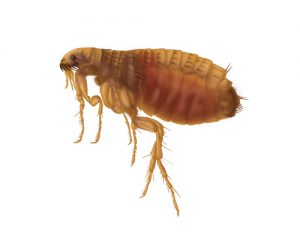Fleas Still A Problem
By Chris Williams on September 14, 2011.
Q. We had a terrible problem with fleas this summer. We had the vet treat our dog about a month ago, but I’m still seeing fleas in the house. I found one on my leg last night. Does that mean the vet’s treatment didn’t work?
A. The vet’s treatment worked, but only for your pet. While fleas may no longer be feeding on your pet, unless you had your home treated, you’ve still got fleas! Flea larvae are quietly developing in the places where your pet rests or spends most of its time, so-called flea “hot spots.” This is why just treating the pet will not solve a flea problem. You’ve killed the adult fleas on your pet but flea eggs have already been laid, and flea larvae are still developing in areas off of your pet. As new adult fleas hatch out, they will attempt to feed on your pet…or on you.
 Adult fleas spend almost all of their time on the animal. When the female flea lays eggs, they fall off of the animal onto the floor, or in the pet’s bed, your bed, on the carpet, wherever the animal is at the time. So it makes sense that most of the flea eggs are going to end up where your pet spends most of its time. The eggs hatch into whitish, wormlike larvae which also spend their time in pet resting sites where they feed mostly on the feces of adult fleas (which contain digested blood from your pet). When mature, the larvae pupate in the same site. The adult flea can remain in its pupal cocoon for a long time if there is not a potential host animal nearby.
Adult fleas spend almost all of their time on the animal. When the female flea lays eggs, they fall off of the animal onto the floor, or in the pet’s bed, your bed, on the carpet, wherever the animal is at the time. So it makes sense that most of the flea eggs are going to end up where your pet spends most of its time. The eggs hatch into whitish, wormlike larvae which also spend their time in pet resting sites where they feed mostly on the feces of adult fleas (which contain digested blood from your pet). When mature, the larvae pupate in the same site. The adult flea can remain in its pupal cocoon for a long time if there is not a potential host animal nearby.
How can you find the “hot spots” where fleas are developing? Pest control inspectors often refer to the “salt and pepper” when they are looking for evidence of fleas. The “salt” is the white flea eggs, shed larval skins, and flea pupae, and the “pepper” is the black feces of the adult flea. Though not very noticeable at first, when you look closely at a flea “hot spot,” you will see that it looks like it was sprinkled with salt and pepper. Though unless you washed all of your pet’s bedding and thoroughly vacuumed when your pet was treated, it will be hard to tell whether you are seeing new or old evidence of fleas.
Check your pet’s sleeping and resting areas. Your pet may have his own pet bed or area, or his main sleeping spot could be on your bed, or at the foot of your bed. One study found that the highest numbers of flea eggs and larvae were found on the floor at the side of the owner’s bed, right where the pet landed when he jumped down. Pets rest in lots of different places during the day such as on the sofa or a favorite spot in the kitchen or next to the fireplace. You’ll need to look under furniture cushions, under furniture, and under rugs, as well. For cats, think about possible infestation sites higher up, like on top of the bookcase or refrigerator.
Some people swear by the “white sock method” to find out whether or not their home has fleas. This method supposedly detects those new adult fleas that are just waiting for a host to pass by. This involves pulling on a pair of tall white socks and walking through suspect areas. Newly hatched fleas will be attracted to the motion and the warmth and you should be able to see them on the socks. Actually, fleas are more attracted to dark colors but are much harder to see on black socks!
Or, you can call Colonial and have a pest control professional do your flea inspection. If you find flea infestation sites, they are going to need to be treated if you expect to be flea-free. We can do that, too. Our technicians know just where to find those flea “hot spots.”